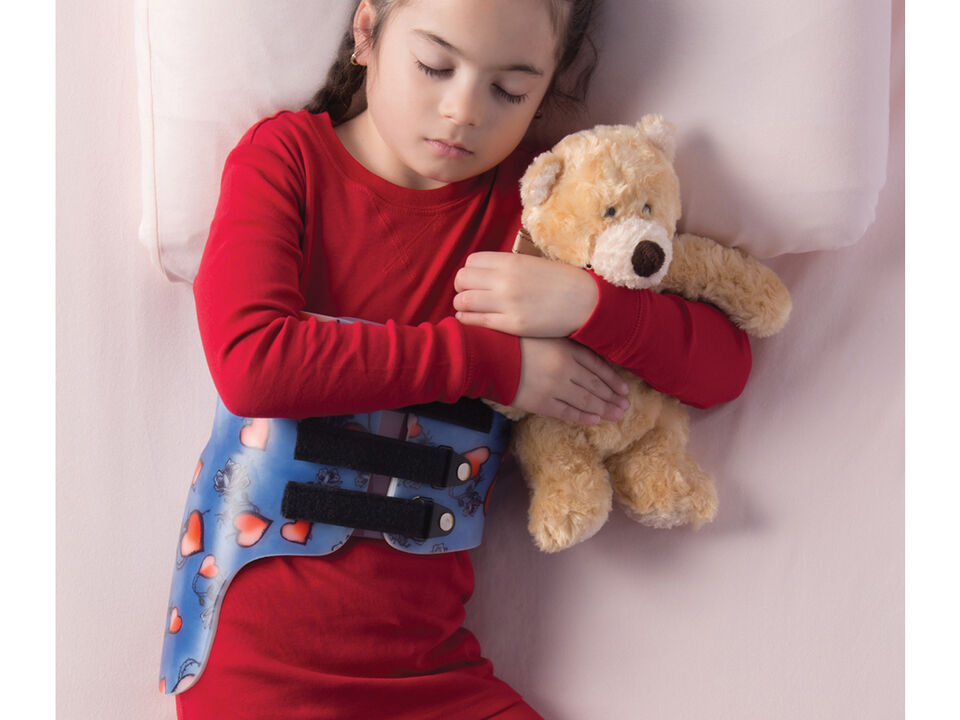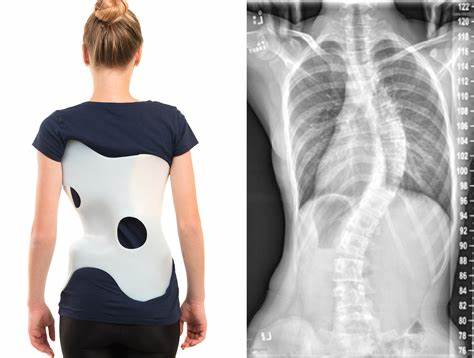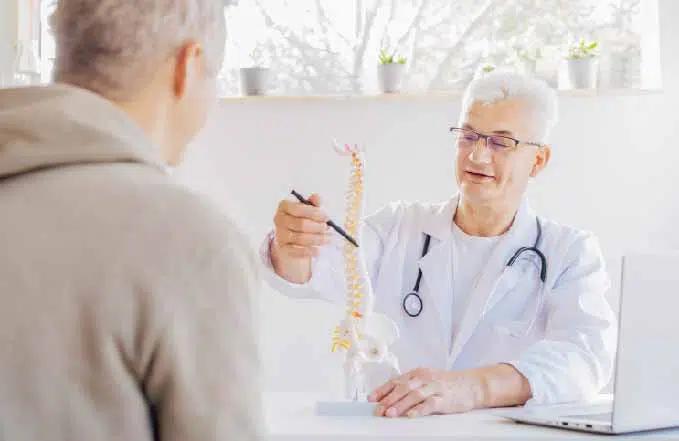La escoliosis es una enfermedad caracterizada por una curvatura anormal de la columna vertebral. Afecta a millones de personas en todo el mundo, con distintos grados de gravedad. Aunque existen diferentes opciones de tratamiento, un método eficaz para controlar la escoliosis durante el sueño es el uso de corsés nocturnos. Los corsés nocturnos son dispositivos ortopédicos especialmente diseñados que ayudan a corregir y estabilizar la columna vertebral mientras la persona duerme. En este artículo analizaremos el papel y la eficacia de los corsés nocturnos en el tratamiento de la escoliosis durante el sueño.
Comprender la escoliosis
Antes de profundizar en el papel de los corsés nocturnos, es importante tener unos conocimientos básicos sobre la escoliosis. La escoliosis puede desarrollarse en la infancia o la adolescencia y puede estar causada por diversos factores, como la genética, desequilibrios musculares o afecciones neurológicas. Esta afección se caracteriza por una curvatura lateral anormal de la columna vertebral, que puede provocar dolor, molestias e incluso problemas respiratorios en los casos graves [1][2].

La necesidad de un corsé nocturno para la escoliosis
Los corsés nocturnos desempeñan un papel crucial en el control de la escoliosis durante el sueño. Cuando una persona con escoliosis se acuesta, la curvatura de su columna puede empeorar debido a la falta de fuerzas gravitatorias. Esto puede provocar una mayor incomodidad y una posible progresión de la enfermedad [3][4]. Los corsés nocturnos ayudan a contrarrestar esta situación proporcionando apoyo externo y manteniendo la alineación correcta de la columna vertebral mientras se duerme [5].
Cómo funciona la ortodoncia nocturna
Los corsés nocturnos ejercen una suave presión sobre zonas concretas de la columna vertebral, lo que favorece su enderezamiento con el tiempo. Suelen estar fabricados con materiales ligeros y transpirables y se ajustan a medida para garantizar la máxima comodidad y eficacia [6][7]. Llevando un corsé ortopédico nocturno de forma sistemática, las personas con escoliosis pueden evitar que la curvatura siga progresando e incluso mejorar la alineación de la columna vertebral [8].

Tipos de ortodoncia nocturna
Existen varios tipos de corsés nocturnos, cada uno diseñado para tratar diferentes grados y tipos de escoliosis. El tipo más común es el corsé Boston, que es un corsé rígido hecho a medida que cubre el torso y se extiende desde las caderas hasta las axilas [9]. Otros tipos son el corsé Charleston bending, que se lleva sólo por la noche y aplica fuerzas correctivas mientras el individuo duerme en una posición específica, y el corsé Providence, que es un corsé más flexible que permite una mayor movilidad durante el sueño [10][11].
Ventajas de la ortodoncia nocturna
El uso de corsés nocturnos ofrece numerosas ventajas a las personas con escoliosis. En primer lugar, proporcionan apoyo y estabilidad a la columna vertebral, reduciendo el dolor y las molestias durante el sueño [12]. Además, los corsés nocturnos pueden ayudar a prevenir una mayor progresión de la curvatura, evitando potencialmente la necesidad de tratamientos más invasivos como la cirugía [13]. También favorecen una mejor postura y alineación, lo que puede mejorar la calidad de vida general de las personas con escoliosis [14].

Eficacia de la ortodoncia nocturna
Los estudios de investigación han demostrado que los corsés nocturnos pueden ser muy eficaces para controlar la escoliosis durante el sueño. Un estudio publicado en la Revista de ortopedia pediátrica descubrió que el uso de un corsé ortopédico nocturno durante al menos ocho horas por noche producía una reducción significativa de la progresión de las curvas de escoliosis en adolescentes [15]. Otro estudio publicado en la Revista Spine demostraron que los corsés nocturnos eran eficaces para evitar la necesidad de cirugía en una mayoría de pacientes con escoliosis moderada [16].
Uso y cuidados adecuados de los aparatos ortopédicos nocturnos
Para garantizar la eficacia de las férulas nocturnas, es importante utilizarlas y cuidarlas adecuadamente. Las férulas nocturnas deben llevarse de forma sistemática tal y como prescriba un profesional sanitario, normalmente durante un mínimo de ocho horas por noche [17]. Es importante seguir las instrucciones del ortopeda o del profesional sanitario sobre la colocación, el ajuste y el mantenimiento de la férula [18]. Puede ser necesario realizar revisiones y ajustes periódicos para garantizar unos resultados óptimos [19].
Posibles efectos secundarios y riesgos
Aunque las férulas nocturnas suelen ser seguras y bien toleradas, existen algunos efectos secundarios y riesgos potenciales que hay que tener en cuenta. Algunas personas pueden experimentar irritación cutánea o úlceras por presión debido al uso prolongado de corsés [20]. Es importante inspeccionar la piel con regularidad e informar de cualquier problema a un profesional sanitario [21]. Además, llevar una férula nocturna puede afectar a la calidad del sueño al principio, pero la mayoría de las personas se adaptan a ella con el tiempo [22].

Opciones de tratamiento alternativas
Aunque los corsés nocturnos son una opción de tratamiento eficaz para controlar la escoliosis durante el sueño, también existen opciones alternativas. La fisioterapia y los programas de ejercicio pueden ayudar a fortalecer los músculos que rodean la columna y mejorar la postura [23]. En algunos casos, puede ser necesaria la cirugía para corregir la curvatura grave de la columna [24]. Es importante consultar a un profesional sanitario para determinar el plan de tratamiento más adecuado para cada persona [25].
Conclusión
En conclusión, los corsés nocturnos desempeñan un papel crucial en el tratamiento de la escoliosis durante el sueño. Proporcionan apoyo y estabilidad a la columna vertebral, impidiendo una mayor progresión de la curvatura y reduciendo el dolor y las molestias [26]. Los estudios de investigación han demostrado su eficacia para reducir las curvaturas de la escoliosis y evitar la necesidad de cirugía [27]. Mediante el uso adecuado y sistemático de corsés nocturnos, las personas con escoliosis pueden mejorar la alineación de su columna vertebral y su calidad de vida en general [28]. Sin embargo, es importante considerar opciones de tratamiento alternativas y consultar con un profesional sanitario para determinar el enfoque más adecuado para las necesidades específicas de cada persona [29].
Referencias
- Weinstein SL, Dolan LA, Cheng JC, et al. "Escoliosis idiopática del adolescente". Lancet. 2008;371(9623):1527-1537. doi: 10.1016/S0140-6736(08)60658-3.
- Negrini S, Donzelli S, Aulisa AG, et al. "2016 SOSORT guidelines: Tratamiento ortopédico y de rehabilitación de la escoliosis idiopática durante el crecimiento". Escoliosis y trastornos de la columna vertebral. 2018;13:3. doi: 10.1186/s13013-018-0175-8.
- Trobisch P, Suess O, Schwab F. "Escoliosis idiopática". Dtsch Arztebl Int. 2010;107(49):875-883. doi: 10.3238/arztebl.2010.0875.
- Hresko MT. "Práctica clínica. Escoliosis idiopática en adolescentes". N Engl J Med. 2013;368(9):834-841. doi: 10.1056/NEJMcp1209063.
- Bettany-Saltikov J, Weiss HR, Chockalingam N, et al. "Intervenciones quirúrgicas versus no quirúrgicas en personas con escoliosis idiopática del adolescente". Cochrane Database Syst Rev. 2015;2015(4). doi: 10.1002/14651858.CD010663.pub2.
- Monticone M, Ambrosini E, Cazzaniga D, et al. "Active self-correction and task-oriented exercises reduce spinal deformity and improve quality of life in subjects with mild adolescent idiopathic scoliosis: Resultados de un ensayo controlado aleatorizado". Eur Spine J. 2016;25(10):3118-3127. doi: 10.1007/s00586-016-4625-4.
- Kotwicki T, Negrini S, Grivas TB, et al. "Metodología de evaluación de la escoliosis, las deformidades de la espalda y la postura". Scoliosis. 2009;4:26. doi: 10.1186/1748-7161-4-26.
- Weinstein SL, Dolan LA, Cheng JC, et al. "Escoliosis idiopática del adolescente". Lancet. 2008;371(9623):1527-1537. doi: 10.1016/S0140-6736(08)60658-3.
- Negrini S, Donzelli S, Aulisa AG, et al. "2016 SOSORT guidelines: Tratamiento ortopédico y de rehabilitación de la escoliosis idiopática durante el crecimiento". Escoliosis y trastornos de la columna vertebral. 2018;13:3. doi: 10.1186/s13013-018-0175-8.
- Trobisch P, Suess O, Schwab F. "Escoliosis idiopática". Dtsch Arztebl Int. 2010;107(49):875-883. doi: 10.3238/arztebl.2010.0875.
- Hresko MT. "Práctica clínica. Escoliosis idiopática en adolescentes". N Engl J Med. 2013;368(9):834-841. doi: 10.1056/NEJMcp1209063.
- Bettany-Saltikov J, Weiss HR, Chockalingam N, et al. "Intervenciones quirúrgicas versus no quirúrgicas en personas con escoliosis idiopática del adolescente". Cochrane Database Syst Rev. 2015;2015(4). doi: 10.1002/14651858.CD010663.pub2.
- Monticone M, Ambrosini E, Cazzaniga D, et al. "Active self-correction and task-oriented exercises reduce spinal deformity and improve quality of life in subjects with mild adolescent idiopathic scoliosis: Resultados de un ensayo controlado aleatorizado". Eur Spine J. 2016;25(10):3118-3127. doi: 10.1007/s00586-016-4625-4.
- Kotwicki T, Negrini S, Grivas TB, et al. "Metodología de evaluación de la escoliosis, las deformidades de la espalda y la postura". Scoliosis. 2009;4:26. doi: 10.1186/1748-7161-4-26.
- Lonstein JE, Carlson JM. "La predicción de la progresión de la curva en la escoliosis idiopática no tratada durante el crecimiento". J Bone Joint Surg Am. 1984;66(7):1061-1071. doi: 10.2106/00004623-198466070-00008.

